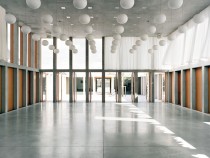
© Kim Zwarts
Merkem, a village in West Flanders, has a population of approximately 2,300. After its destruction in the First World War, it was rebuilt in the traditional regional style. The new municipal centre, with its symmetrical layout, occupies a site 150 m long and 40 m wide on one of the two main streets. The village hall was conceived as an open platform for a wide range of events and activities.
Visitors enter the foyer from a public forecourt and proceed along the central axis to the hall. In the front section, the facade bays of the concrete grid structure are fully glazed, while those to the rear are closed on the ground floor with timber panels. Doors open the hall across its entire width to a sheltered courtyard, to which a small assembly room at the end of the axis is oriented. The peripheral arcades continue along the courtyard in the form of open colonnades. The hall itself, which rises above the strict grid of the plinth, is two storeys high. A strip of fenestration in the upper part of the grid ensures ample natural lighting, while at night, the hall has the appearance of an illuminated beacon marking the cultural centre of the village. The classical order of the facade, with its precast concrete elements, the cubic form of the development and the materials used distinguish the centre as a public building from the surrounding fabric, which consists largely of two-storey houses with brick walls and pitched roofs.
Visitors enter the foyer from a public forecourt and proceed along the central axis to the hall. In the front section, the facade bays of the concrete grid structure are fully glazed, while those to the rear are closed on the ground floor with timber panels. Doors open the hall across its entire width to a sheltered courtyard, to which a small assembly room at the end of the axis is oriented. The peripheral arcades continue along the courtyard in the form of open colonnades. The hall itself, which rises above the strict grid of the plinth, is two storeys high. A strip of fenestration in the upper part of the grid ensures ample natural lighting, while at night, the hall has the appearance of an illuminated beacon marking the cultural centre of the village. The classical order of the facade, with its precast concrete elements, the cubic form of the development and the materials used distinguish the centre as a public building from the surrounding fabric, which consists largely of two-storey houses with brick walls and pitched roofs.



